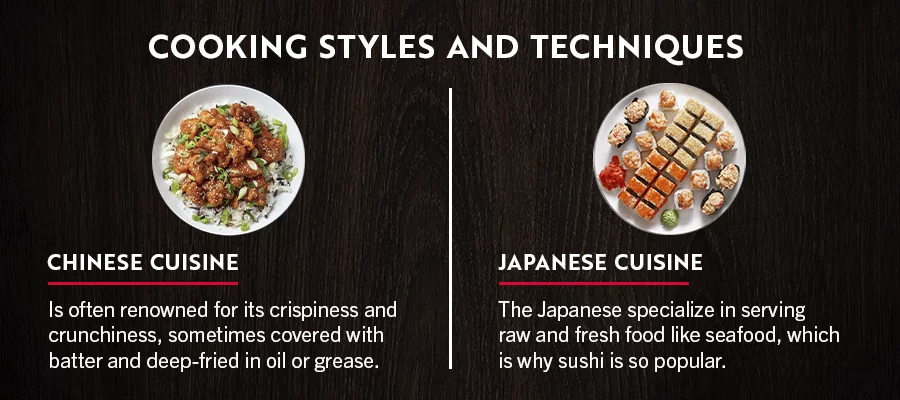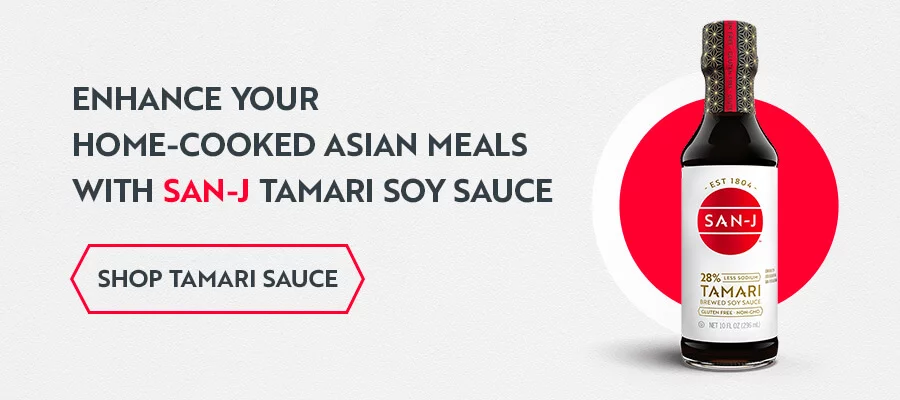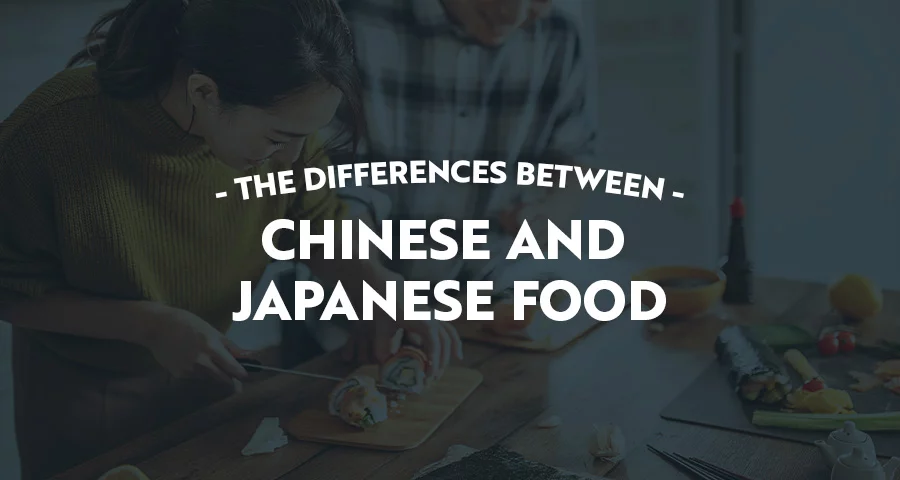Asian food is considered one of the most popular and flavorful cuisines available. It is not only enjoyed in their home countries but is also sought after across nations for its bold taste and delicious flavor profiles.
How different are Chinese and Japanese dishes? They seem alike, but there are some significant variances that set them apart from one another. The East-Asian regions boast Chinese and Japanese culinary traditions that are rooted in their individual nuances. We’ll explore Chinese vs. Japanese food, how interest in these dishes has grown in Western culture and why our delicious SAN-J Tamari Soy Sauce goes well with any dish you prepare.
Popular Chinese and Japanese Foods in Western Culture
Both Chinese and Japanese cuisines are recognized globally for the array of dishes that are full of flavorful ingredients. Many dishes have become a regular part of Western cuisine. Some dishes are more popular than others, but it’s interesting to note the more common ones so that you’re aware of which foods originate in either country.
Popular Chinese Food
These are some of the most popular Chinese foods:
- Hotpot
- Fried rice and other rice dishes
- Dumplings
- Chow mein
- Stirfry
- Sweet and sour pork
- Peking duck
- Egg rolls
- Wontons
Popular Japanese Food
Some beloved Japanese staples include:
- Sushi
- Ramen
- Tempura (deep-fried seafood and vegetables)
- Various noodles and rice dishes
- Takoyaki
- Teriyaki
- Japanese curry
- Yakisoba
- Yakitori
- Miso soup
- Matcha tea
Similarities Between Chinese and Japanese Cuisine
Though both are rooted in East Asia, there are not as many similarities between Chinese and Japanese food as you may have thought there are. The main similarity is that they both require fresh ingredients. This is important if you want authentic tastes and textures. Fish, vegetables and meat must be as fresh as possible to prepare and enjoy meals.
Although the Chinese generally serve a variety of sauces with their meals, both cultures predominantly use soy sauce as a condiment with rice dishes and other cuisines. It’s worth noting that there are several types of soy sauce in East Asia, and Japanese and Chinese soy sauces offer a different culinary experience.
Differences Between Chinese and Japanese Cuisine
Compared to these similarities, there are notable differences that distinguish the two, namely in their flavor profiles, ingredients and preparation methods.
Flavor Profile and Ingredients
Flavor is what makes any dish unique. The presence or lack thereof can make you love or hate it. Find out more about the preferred flavor profile and ingredients used in Chinese and Japanese cuisine.
Chinese Cuisine
In China, rice and noodles are the main staple foods. Dairy products aren’t common in dishes, and most diners enjoy a variety of sauces drizzled over their meals. Chinese food is rich in flavor and textures — they don’t hold back on spices. If you enjoy hot and spicy meals, Chinese dishes offer varying heat degrees to tantalize your tastebuds. A lot of Chinese cooking is built around three key aromatic ingredients — garlic, scallions and ginger.
As far as protein goes, some of the options are beef, chicken, pork, or duck served with rice or in noodle dishes.
Japanese Cuisine
In Japan, the staple is also mainly rice. It is ideally served with two complementary vegetable-based side dishes along with the protein mains. The flavor profiles are less extreme, with fewer spices and more focus on enhancing the natural flavors of food with minimal seasoning. Simply put, less tends to be more in Japanese food. That said, many Japanese dishes are served with extras like wasabi or spices like togarashi (Japanese hot pepper).
Protein options include beef, chicken, pork, salmon, shrimp, lobster or calamari to cater to a variety of eaters.
Cooking Styles and Techniques
Like their flavor preferences, individual cooking techniques vary between the Chinese and Japanese. Here’s how.

Chinese Cuisine
Chinese food is often renowned for its crispiness and crunchiness, sometimes covered with batter and deep-fried in oil. It is rich in carbohydrates, and staples like rice and noodles ensure the food never lacks flavor and is always filling. Naturally, the carb-based meal portions are larger and heavier, so you feel full quicker and for longer.
Japanese Cuisine
On the other hand, Japanese food is prepared using less oil. These traditional meals are lighter and easier to digest. They serve proportionately sized dishes that fill but leave space for a second helping or dessert. The Japanese specialize in serving raw and fresh food like seafood, which is why sushi is so popular. Due to their preference for subtle flavors, they don’t usually prepare meals that are very hot or spicy unless requested.
Meal Preparation and Presentation
Another distinction between Chinese and Japanese food is how they are prepared and presented when served.
Chinese Cuisine
Chinese meals are prepared in a wok using vegetable or sesame oil. These dishes abound in flavor, color and aroma, which appeals to a large demographic. Meals are traditionally served on one plate or in a single bowl to allow diners to enjoy the mixture of ingredients. If you enjoy wholesome, tasty food, Chinese food is ideal for you.
Japanese Cuisine
Anyone who prefers less oil during preparation may opt for Japanese food. Traditional Japanese cooking uses no or less oil, maximizing the natural flavors of ingredients with minimal seasoning, which can make it a healthier alternative to preparing food. Japanese dishes are generally served as separate foods in different plates or bowls instead of being mixed.
Enhance Your Home-Cooked Asian Meals With SAN-J Tamari Soy Sauce
East Asian foods are a global favorite for a good reason. Both Japanese and Chinese cuisine offers an array of exciting flavors and fresh ingredients, sure to please any tastebud.
If you’re trying out a new Chinese or Japanese recipe you’ve come across, you’ll be delighted by our variety of sauces that will complement your dish and introduce a taste of authenticity. Our Tamari Soy Sauce range is brewed with 100% soybeans, no wheat, is certified gluten-free, and enhances any meal you’ve prepared. Once you’ve gathered all your ingredients, don’t forget to check our store locator to add our Tamari Soy Sauce to your list of essentials. You can also view some of our favorite recipes online for inspiration as you cook up your next meal.



